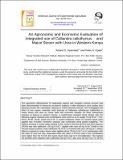An agronomic and economic evaluation of integrated use of Calliandra callothyrsus and maize stover with urea in western Kenya
Abstract/
The agronomic effectiveness of integrating organic and inorganic nutrient sources has been demonstrated in Kenya but economic analysis is often lacking in such studies thus denying farmers the information required to make informed choices. We investigated the effect of two organic materials; leafy biomass of Calliandra callothyrsus (calliandra) or maize stover and urea on maize yield and economic benefits for three consecutive seasons at Bukura in western Kenya. A randomized complete block design with the following organic material:urea combinations were used so as to supply 75 kg N ha-1; 75:0, 60:15, 40:35, 35:40, 15:60 and 0:75. A control treatment where no nutrient inputs were applied was included. Economic analysis was conducted using partial budgeting. The highest increase in maize yields relative to the control in the first (107%) and third seasons (142%) was with calliandra (30 kg N ha-1) applied with urea (45 kg N ha-1) while in the second season (163%) it was calliandra (45 N ha-1) combined with urea (30 kg ha-1). Maize failed to respond to maize stover when applied alone (75 kg N ha-1) or in combination with low rates of urea but only responded when the rates of N from urea in the combination were higher than the N from the maize stover likely due to N immobilization. The highest net benefits were obtained with Calliandra(30 kg N ha-1) plus urea (45 kg N ha-1) in all the Original Research Article
81 seasons. None of the treatments gave a benefit cost ratio (BCR) of > 2 which is considered adequate if a farmer has to adopt a particular technology. Thus despite the good agronomic performance obtained by combining calliandra (30 kg N ha-1) with urea (45 kg N ha-1), it is unlikely that farmers would adopt the practice mainly because of the high labour costs involved.

